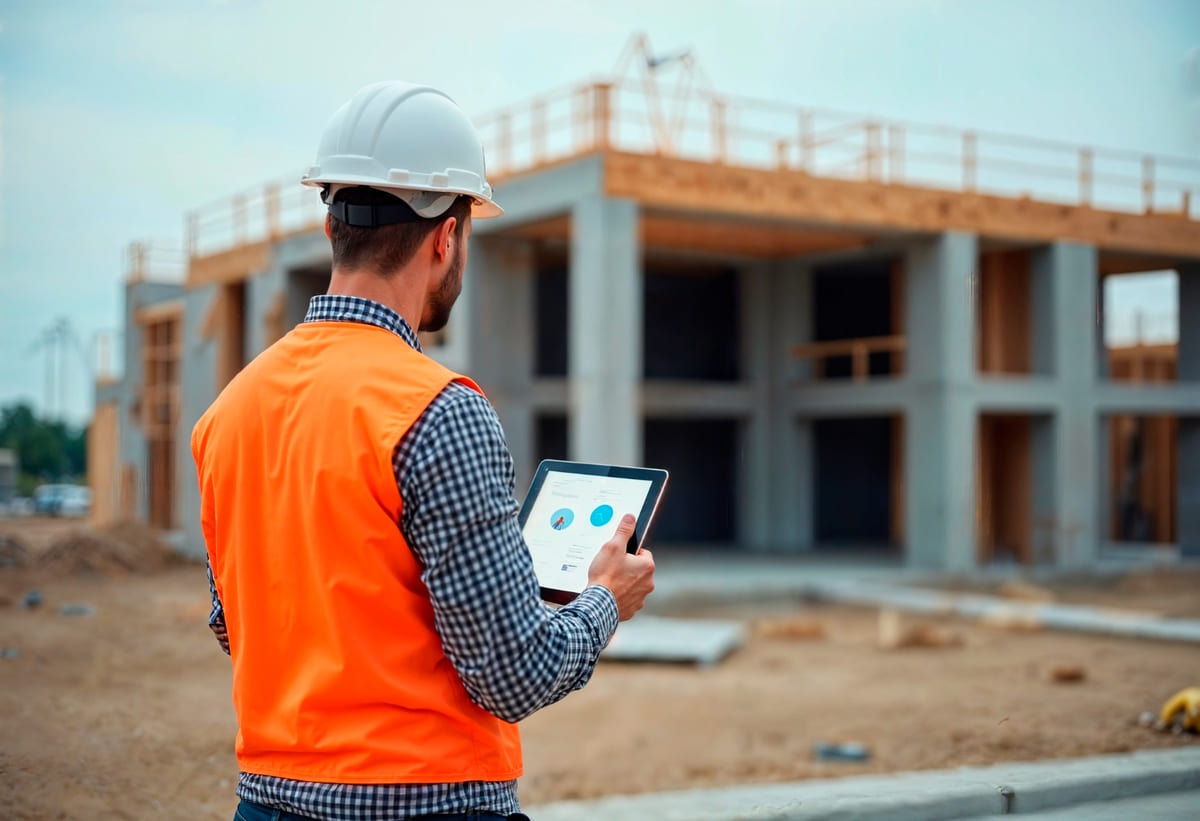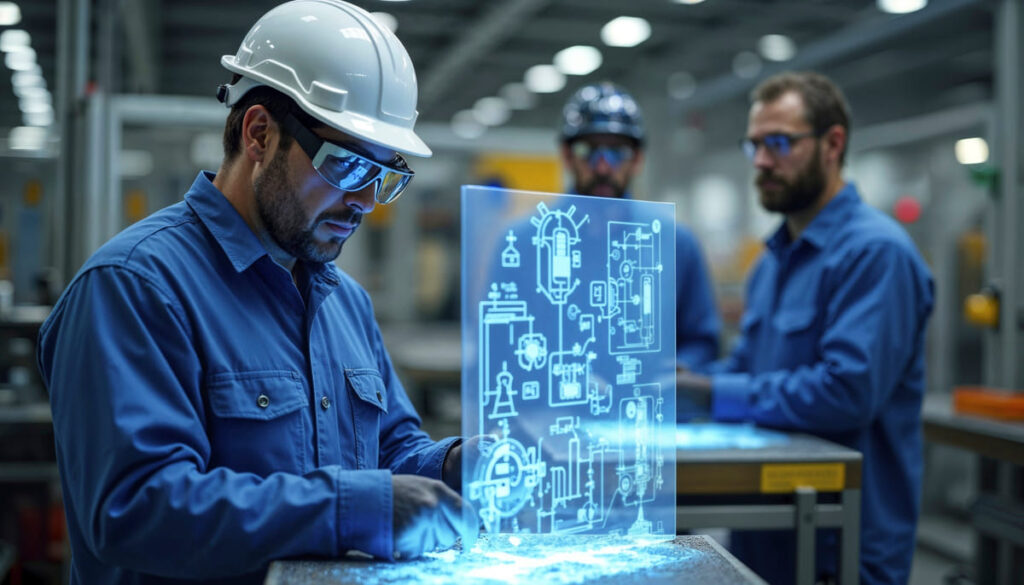Sustainable construction has become a core priority in 2025, as the built environment is responsible for nearly 40% of global carbon emissions. Modern construction projects are turning to advanced sensor technologies to monitor energy use, track materials, protect the environment, and ensure structural safety. This technical overview highlights six Sensor Technology Leaders – globally recognized companies – and explains how their sensor-based solutions are enabling greener, more efficient construction. Each leader is profiled with practical examples of their products in action, from smart energy monitoring in buildings to IoT tracking of materials and structural health monitoring of infrastructure.
Table of Contents
Siemens AG: Smart Infrastructure and Energy Monitoring
Siemens is a longstanding leader in building automation and smart infrastructure. The company’s sensors and control systems make buildings more energy-efficient and sustainable by automatically adjusting operations based on real-time data. Siemens deploys networks of connected sensors in facilities to measure conditions like temperature, humidity, CO₂, light levels, and occupancy. These devices feed into Siemens’ building management software (such as the Desigo platform), which optimizes heating, cooling, and lighting usage to avoid waste while maintaining comfort.
Key Sustainable Solutions
Siemens provides sensor-driven solutions that help decarbonize building operations:
Notable Solutions:
-
Climate & Occupancy Sensors: Siemens HVAC sensors continuously monitor indoor temperature, air quality, and room occupancy. The system uses this data to adjust ventilation, heating, and cooling in each zone – for example, dialing back airflow and turning off lights in empty rooms – resulting in less wasted energy.
-
Energy Metering and Analytics: Siemens smart meters and power sensors track electricity usage of equipment and lighting in real time. The data is analyzed to find inefficiencies (such as systems running when not needed). Facility managers get actionable insights to implement energy-saving measures, often achieving double-digit percentage reductions in building energy use.
Real-World Application
Siemens’ sensor technology has delivered substantial savings in many projects. For instance, an energy retrofit of 18 municipal buildings in Massachusetts used Siemens environmental sensors and automation controls to cut power and fuel consumption, saving the city about $100,000 in energy costs in the first year. Likewise, in green office buildings around the world, Siemens smart infrastructure solutions typically lower HVAC and lighting energy usage by 20% or more through sensor-optimized scheduling and real-time control.

Schneider Electric: IoT Sensors for Energy and Environment
Schneider Electric is another global leader driving sustainable construction through IoT sensor networks. Specializing in energy management and automation, Schneider provides sensors and software under its EcoStruxure™ platform to improve building efficiency. In green buildings, Schneider’s wireless sensors measure everything from room temperature and humidity to occupancy and air quality. These devices connect to cloud-based controls that continuously fine-tune HVAC and lighting for optimal efficiency.
Key Sustainable Solutions
Schneider Electric offers a suite of sensor-based solutions to maximize sustainability:
Notable Solutions:
-
SpaceLogic™ Multi-Sensors: Schneider’s SpaceLogic Insight sensor devices detect occupancy, motion, light level, noise, temperature, and humidity – all in one unit. By capturing multiple data points, a building management system can perform fine-tuned, room-by-room control (like dimming lights and moderating ventilation when a room is unoccupied), resulting in significantly less wasted energy.
-
Indoor Air Quality Sensors: To support health and efficiency, Schneider’s air quality sensors monitor CO₂ levels and airborne pollutants in real time. Ventilation systems respond automatically – increasing fresh air intake when carbon dioxide rises or cutting back when rooms are empty – balancing optimal air quality with energy savings.
Real-World Application
Schneider’s sensor technologies are proven in cutting-edge sustainable buildings. A prime example is the company’s own IntenCity office building in France, which operates at net-zero energy. IntenCity is outfitted with thousands of IoT sensors tied into EcoStruxure; the sensor data allows dynamic control of lighting, climate, and even window shading. As a result, IntenCity uses only about 10–15% of the energy of a conventional office building its size.
Suggested article to read: Discovering the World’s Top 29 Sustainable Buildings
Honeywell International: Environmental and Safety Sensing
Honeywell is a global leader in building technologies and a pioneer in sensors for environmental monitoring and safety. In sustainable construction, Honeywell’s solutions range from smart thermostats and occupancy detectors to advanced gas and air quality sensors. Data from these devices feeds into Honeywell’s building management systems (such as Honeywell Forge), which optimize operations to save energy while upholding safety.
Key Sustainable Solutions
Honeywell’s portfolio includes sensor technologies that contribute to greener, safer buildings:
Notable Solutions:
-
Smart Climate Control Sensors: Honeywell offers intelligent thermostats and occupancy sensors that work together to control HVAC and lighting. These devices learn usage patterns and detect when rooms are vacant, enabling automatic temperature setbacks and lights-off scheduling that cut energy waste without sacrificing comfort.
-
Air Quality and Gas Detection: Honeywell’s environmental sensors continuously measure indoor air quality – tracking CO₂, volatile organic compounds, smoke, or specific hazardous gases. The ventilation adjusts based on these readings to ensure healthy air while avoiding excessive ventilation. In addition, leak detectors and gas sensors help prevent losses of refrigerants or natural gas, improving safety and avoiding environmental harm.
Real-World Application
Honeywell’s sensor technology has been implemented in many high-performance green buildings. For example, a 30-story office tower in Toronto integrated Honeywell’s smart building system with thousands of climate and occupancy sensors. The result was about a 25% reduction in overall energy costs thanks to strategies like automated lighting shutoff and zone-by-zone HVAC adjustments.

Johnson Controls: Smart Building Systems and OpenBlue IoT
Johnson Controls is widely recognized for its building automation and controls. Today, it remains a sensor technology leader through its OpenBlue digital platform and extensive suite of building sensors. Johnson Controls deploys IoT sensors to monitor temperature, humidity, occupancy, energy usage, and equipment status throughout a facility. The OpenBlue software then analyzes this data to optimize operations – for example, adjusting HVAC output based on actual occupancy or powering down systems after hours. By deploying dense sensor networks, Johnson Controls helps owners cut energy usage, shrink carbon footprints, and improve occupant comfort simultaneously.
Key Sustainable Solutions
Johnson Controls delivers numerous sensor-driven capabilities for sustainable buildings:
Notable Solutions:
-
OpenBlue Connected IoT Sensors: Under the OpenBlue platform, Johnson Controls uses wireless sensors to gather real-time data on building conditions and energy use. The system makes predictive adjustments that lower energy consumption and costs – such as pre-cooling areas only when occupancy is expected or shutting off idle equipment.
-
HVAC Control and Efficiency Sensors: Johnson Controls produces a wide range of HVAC sensors (temperature, pressure, flow, etc.) that integrate with its building management systems. These sensors ensure heating and cooling equipment operates at peak efficiency – providing just enough climate control based on demand. By avoiding over-conditioning and quickly responding to changes (like a full conference room or a cold draft), they help minimize wasted energy while keeping indoor climates stable.
Real-World Application
Johnson Controls’ sensor-centric approach has transformed many buildings into high-efficiency facilities. In one prominent skyscraper retrofit, the company installed hundreds of smart sensors and its automation system, resulting in a more than 20% reduction in annual energy use for the building. These sensors also ensure improved indoor air quality and consistent comfort, adding to both the sustainability and occupant well-being of the space.
Trimble Inc.: Structural Health and Construction Site Monitoring
Trimble is a technology company known for positioning and surveying equipment, and it plays a key role in applying sensors for sustainable construction and infrastructure. Unlike the previous companies focusing on building interiors, Trimble’s expertise lies in the field – providing structural health monitoring and construction site sensor solutions. Trimble’s instruments are used to track the stability of structures and earthworks over time. The company also offers systems that monitor heavy machinery and guide construction equipment. By improving construction accuracy and catching structural issues early, Trimble’s sensor solutions help prevent resource waste and extend the lifespan of critical infrastructure.
Key Sustainable Solutions
Trimble’s technologies show how sensors can lead to more efficient construction and longer-lasting assets:
Notable Solutions:
-
Structural Monitoring Sensors: Trimble deploys sensors on bridges, tunnels, dams, and buildings to measure any movements or stresses. The system analyzes this data in real time and alerts engineers to any anomalies. Early warning of structural strain or settlement means maintenance can be performed before a small issue becomes a major problem, preserving the structure and avoiding costly rebuilds.
-
Machine Control & Telematics: Trimble’s machine guidance systems direct earthmoving equipment with high precision to reduce rework and save fuel, while telematics sensors track idle time and engine use to cut unnecessary fuel burn on site.
Real-World Application
Trimble’s sensor solutions have been employed on major infrastructure projects worldwide. For instance, on a long-span bridge, Trimble sensors detected minor stress changes in support cables that triggered timely repairs – effectively extending the bridge’s service life. Contractors using Trimble’s GPS machine control have also reported finishing earthwork jobs faster and using up to 30% less fuel, since precise sensor guidance prevents unnecessary passes. These examples highlight how Trimble’s technology contributes to sustainability by building right the first time and safeguarding infrastructure.

Zebra Technologies: Material Tracking and Waste Reduction
Zebra Technologies specializes in real-time tracking and identification solutions, and its products are increasingly used on construction sites to support sustainable practices. The company’s RFID tags, barcode labels, and tracking software allow construction materials and assets to be monitored automatically. With these tools, project teams gain real-time visibility into inventory and logistics – ensuring materials are available when needed, not lost, and not over-ordered. By using sensors and scanning technology to streamline material management, Zebra’s solutions help cut down excess waste and idle inventory in construction.
Key Sustainable Solutions
Zebra’s offerings illustrate how digital tracking can make construction greener and leaner:
Notable Solutions:
-
RFID Tags and Readers: Zebra provides durable RFID tags that attach to building materials (steel, timber, pallets) and equipment. Each tag broadcasts a unique ID that fixed or handheld readers automatically detect at entry points, logging item movements and locations. This real-time tracking prevents materials from getting misplaced on large sites and enables just-in-time delivery of supplies.
-
Inventory Analytics Platforms: Data from Zebra’s tracking system feeds into software that gives managers a clear picture of stock levels and material usage, helping avoid over-ordering and ensuring unused items are recovered or recycled.
Real-World Application
Zebra’s tracking technology is helping construction firms eliminate wasteful practices in the supply chain. In the UK, an industry initiative is fitting RFID tags to reusable wooden pallets that carry construction materials. Each year, tens of millions of pallets are typically used once and discarded on job sites. With RFID tracking, those pallets can be collected and reused many times, preventing a huge amount of timber waste. These kinds of sensor-driven improvements show how technologies from Zebra contribute to sustainable construction by promoting a more circular and efficient use of resources.
FAQs
How are sensors improving sustainability in construction projects?
Sensors allow construction teams to monitor and control resources with precision, which directly improves sustainability. For example, energy sensors track electricity and fuel usage in real time so that inefficiencies can be identified and corrected quickly, reducing waste. Environmental sensors (monitoring factors like air quality, temperature, and noise) enable builders to minimize harmful impacts such as excessive dust or carbon emissions on site. By providing data on everything from equipment performance to material location, sensors help optimize operations – leading to lower energy consumption, less rework, and better conservation of materials. In short, sensors make construction processes more data-driven and efficient, which means projects can achieve green building goals more easily.
What types of sensor technologies are used in sustainable building?
Sustainable buildings use a wide array of sensor technologies. Key examples include temperature and climate sensors for managing heating and cooling systems efficiently, occupancy/motion sensors that control lighting and HVAC based on whether people are present, and air quality sensors that measure CO₂ and other pollutants to ensure healthy indoor environments.
Buildings also employ smart energy meters on electrical panels and equipment to monitor power usage in detail. For structural safety and maintenance, there are vibration and strain sensors to detect structural issues or monitor building movement over time. Additionally, smart buildings integrate water flow sensors (to detect leaks and conserve water) and daylight sensors (to adjust lighting based on natural light). Together, these sensor technologies create an intelligent building that automatically fine-tunes itself for optimal sustainability and comfort.
Which companies are leading in sustainable construction sensor technology?
Several major companies stand out as leaders in sustainable construction sensor tech. Global firms like Siemens, Schneider Electric, Honeywell, and Johnson Controls are at the forefront in smart building automation – their sensors and IoT platforms manage energy, climate, and safety in green buildings worldwide. In infrastructure and site monitoring, Trimble is a leader, providing sensors for structural health monitoring and machine control that improve construction accuracy and longevity.
For materials and asset tracking, companies such as Zebra Technologies offer industry-leading RFID and real-time location solutions that help reduce waste. These sensor technology leaders have proven track records in enabling sustainable practices, and they continue to innovate new ways to gather and use data on construction projects for better environmental outcomes.
Is it true that sensors can extend the life of a building?
Yes. Sensors play a crucial role in extending the lifespan of buildings and infrastructure. Through structural health monitoring, sensors like strain gauges, accelerometers, and tiltmeters continuously check the condition of structures – detecting issues such as unusual vibrations, settlement, or material fatigue at an early stage. This data allows maintenance teams to address small problems before they escalate, thereby preventing serious damage.
For instance, sensors embedded in a bridge can alert engineers to subtle stress changes in the structure, so repairs can be made before any component fails. By keeping buildings “healthy” through preventative maintenance, sensors help avoid premature deterioration. Additionally, environmental sensors ensure that HVAC systems run correctly (preventing moisture or mold problems) and that building materials aren’t exposed to damaging conditions, further preserving the structure. In these ways, sensor technology contributes to a much longer, safer service life for buildings and infrastructure.
Conclusion
In 2025, these six Sensor Technology Leaders – Siemens, Schneider Electric, Honeywell, Johnson Controls, Trimble, and Zebra Technologies – are at the forefront of making construction more sustainable through innovative sensor systems. Each company brings a distinct expertise: the building automation giants (Siemens, Schneider, Honeywell, Johnson Controls) use sensors to slash energy usage and emissions in buildings; Trimble ensures construction quality and infrastructure longevity with structural and machine sensors; and Zebra improves material efficiency and waste reduction through tracking technology.
The common thread is the strategic use of real-time data from sensors to drive smarter, greener decisions in construction. By deploying technologies such as energy and HVAC sensors, environmental monitors, RFID trackers, and structural health sensors, the industry can significantly lower its environmental impact. These leaders provide practical tools to turn sustainable construction goals into measurable results, from cutting operational energy costs to extending the life of structures and cutting material waste.
Resources:
- World Green Building Council. (2021). WorldGBC Net Zero Carbon Buildings Commitment expands to include embodied carbon.
- United Nations Environment Programme. (2023). Building Materials and the Climate: Constructing a New Future.
- Oregon Tech News. Korivi, N. (2025). Research Sheds New Light on the Role of Sensors in Advancing Green Building Technology.
- MarketsandMarkets. (2023). Building Automation System Companies – Leading manufacturers and suppliers. Published Nov 2023.
- RFID Journal. (2024). RFID Builds Sustainability into Construction Pallet. Published May 2024.
For all the pictures: Freepik
Suggested article for reading:
Digital Fabrication 2025: How AI and Robotics Are Revolutionizing Manufacturing
Top 7 Asset Tracking Technologies Transforming Construction Industry in 2025
A Guide to Selecting the Best Software for Construction Business 2025
7 Types of Asset Tracking Technologies and Their Applications in Construction
4 Streamlining Construction Supply Chains with AI-Powered Platforms



